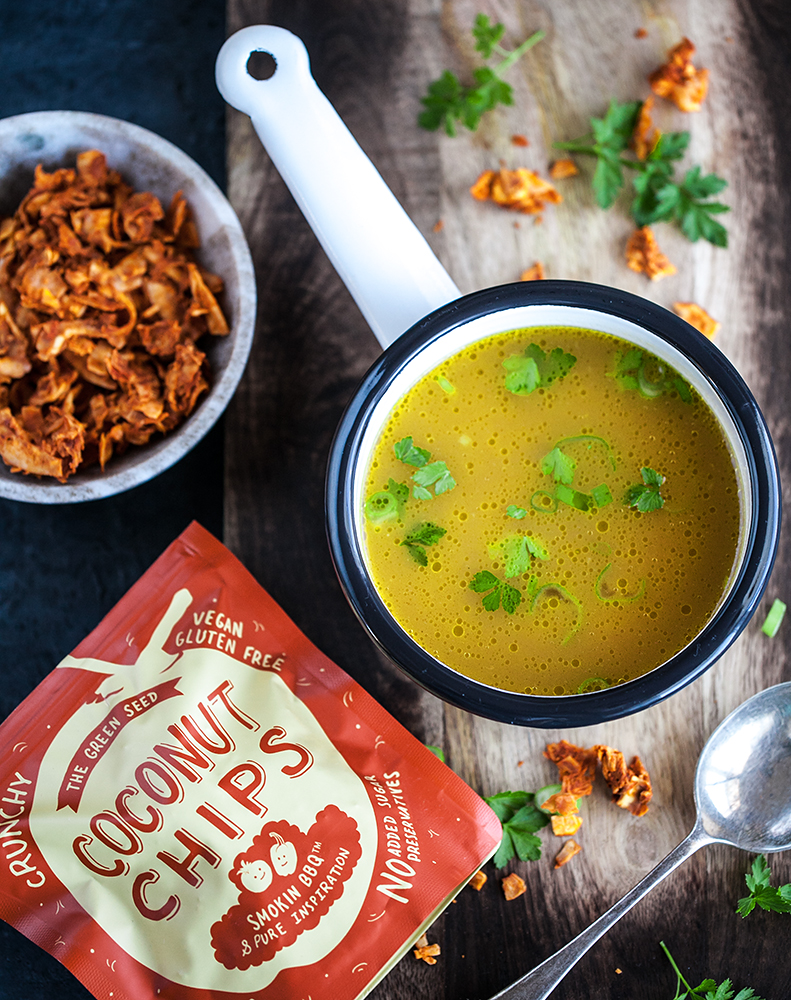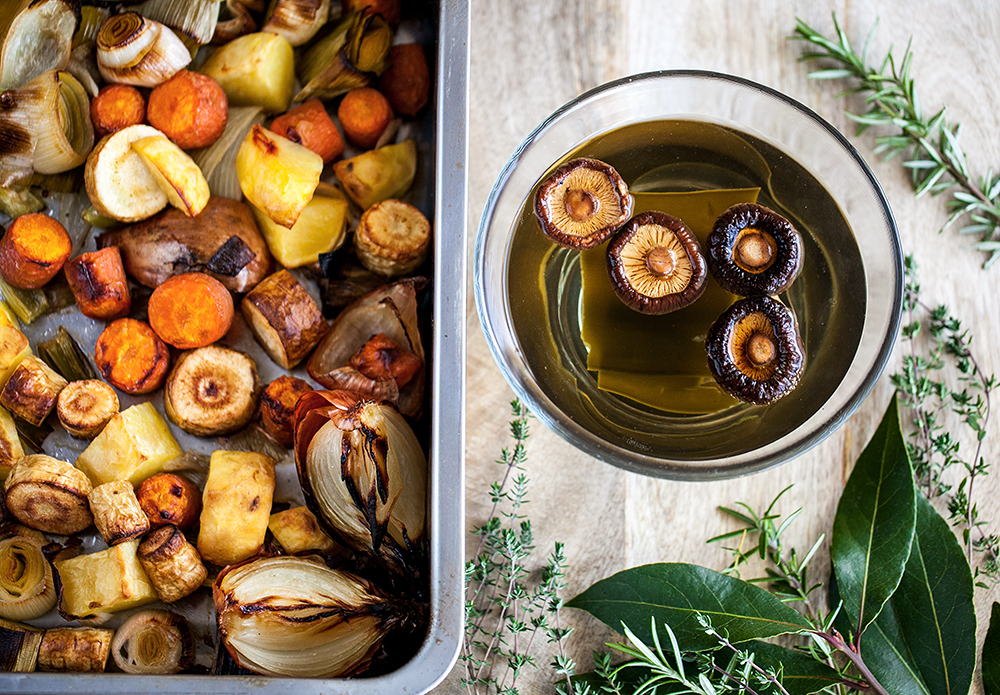How to make vegetarian food taste better? How to make the flavor of your meals richer? Making vegetarian healthy food taste good is not a matter of genius: it’s about knowing the tricks to do so, and anyone can do it.
In this recipe, I will share with you some culinary techniques and ingredients which I learned in culinary school. Check out a few tips for ways to get the most flavor out of your vegetables. And take out your vegetable broth to a new level.
This broth can be enjoyed alone. It’s the kind of thing that’s perfect for sipping from a mug on a cold day. I like to serve it with croutons or Smokin BBQ coconut chips , it’s so satisfying. Or can be used in your favorite recipes.

Roast your vegetables first.
The roasting caramelizes vegetables, and we all know what browned and caramelized means better flavor. This adds an extra depth of flavor and richness to the soup, plus it makes a beautiful dark-colored broth.
I like to add to the broth brown onion leaving the skin on. Onion skins not only add quite a bit of flavour, but also give the broth a beautiful natural brown color. I also never peel the vegetables for broth. I just scrub them and cut out any bruised looking bits. Use potatoes or potato peelings to add body. Agria potato works well.
Add umami-rich ingredients.
It has been over a century since umami was discovered in Japan, but umami is just now attracting global attention, primarily from chefs and others with a strong interest in food.
Umami is the fifth taste, joining sweet, sour, salty and bitter. These are unique tastes that cannot be created by mixing other tastes and are known as the basic, or primary tastes. Umami is a general term used mainly for substances combining the amino acid glutamate, and/or the nucleotides inosinate and guanylate, with minerals such as sodium and potassium.
Glutamate is found in a variety of foods including seaweed, meat, fish, and vegetables. Inosinate is found in generous quantities in animal-based foods such as meat and fish, while large amounts of guanylate can be found in dried mushroom products such as dried shiitake. Also known that the umami component of food increases as a result of processing such as ripening and fermentation.
Umami can be found in a number of common kitchen ingredients: Parmesan cheese, olives, tomatoes, soy sauce, sweet corn and sauerkraut and more. Try working with some of these umami-rich ingredients to see how the fifth taste can add yet another layer of flavor to your dishes.
I add some soaked shiitake mushrooms, kombu seaweed, and miso just to enhance the flavour of the broth. You can add a little bit more and get classic miso dashi, the perfect base for ramen soup.

Kombu seaweed (kelp)
Kombu (dried kelp) dried seaweed full of umami flavour and natural glutamates. This is a basic ingredient in Japanese cuisine used to make dashi stock. Kombu-kelp contains glutamic acid, which enhances flavour and gives the body to kombu stock.
Good kombu is covered on the surface with a fine white powdery substance. Do not wash this off – it’s not caked on salt or dust! It’s full of that umami we want to extract.
Soak kombu strip (see the photo above) in cold water for about 10 hours. You need 10 grams of kombu per 1 liter of cold water. Bring to the boil the liquid and seaweed. Then discard the kombu. If you continue cooking dashi is getting gradually stronger in flavor, tasting like the sea.
Dried Shiitake Mushrooms
Dried shiitake mushrooms actually have a deeper flavor than fresh. This makes them an important ingredient for soups and sauces in Chinese and Japanese cuisine. Dried shiitakes require soaking before you can use them. Don’t waste that liquid — use it in the place of vegetarian stock. Shiitake stock is vegetarian dashi in Japanese cooking. Dashi is a Japanese stock or broth, and it is a fundamental ingredient in many Japanese dishes.
White Miso Paste (Shiromiso)

Miso is a traditional Japanese seasoning produced by fermenting soybeans with salt and koji (the fungus Aspergillus oryzae) and sometimes rice, barley, or other ingredients. The result is a thick paste used for sauces and spreads, pickling vegetables or meats, and mixing with dashi soup stock to serve as miso soup, a Japanese culinary staple. High in protein and rich in vitamins and minerals, miso played an important nutritional role in feudal Japan. Miso is still widely used in Japan, both in traditional and modern cooking, and has been gaining worldwide interest.
Typically, miso is salty, but its flavor and aroma depend on various factors in the ingredients and the fermentation process. Different varieties of miso have been described as salty, sweet, earthy, fruity, and savory.
White miso is made from soybeans that have been fermented with a large percentage of rice. The actual resulting color can range from white to light beige, and the miso has a definite sweet taste.
Have you already tried Miso-Glazed Eggplant with Tahini sauce from Crazy Cucumber Blog?

Ultra Satisfying Vegetable Broth. Vegan, GF recipe.
Ingredients
- 2 carrots, unpeeled
- 1 parsnip, unpeeled
- 1 leek
- 1 starchy potato (I use Agria)
- 1 big brown onion unpeeled
- 4 celery stalks
- 1 strip of dried kombu soaked overnight in 1L of cold water
- 4 small dried shiitake mushrooms soaked for about 4 hours in 1L of cold water
- 1 sprig of rosemary
- 2 sprigs of thyme
- 2 bay leaves
- 5 black peppercorns
- 2 sprigs of parsley
- 1 Tbsp white miso
- cooking oil (I use grapeseed oil)
- sea salt, black pepper
To serve:
- Spring onion finely sliced
- Chopped parsley
- The Green Seed Smokin BBQ coconut chips
Directions
- Preheat oven up to 230C.
- Scrub and wash vegetables. Cut vegetables into rough chunks. Drizzle with oil, season with a little salt and freshly ground black pepper. Toss to coat.
- Tip the vegetables into the tray or roasting pan. Spread them out evenly into one layer – this is important, as you want them to caramelize, not steam as they will if you have them all on top of each other. Roast vegetables in the oven for about 30 minutes, or until brown edges.
- Transfer caramelized vegetables into a soup pot, add shiitake mushrooms and kombu with soaking liquid. Add herbs, peppercorns and bay leaves. Add more water if needed, all vegetables need to be covered with water.
- Bring to the boil, then discard kombu. Continue to cook on low heat until the vegetables are super soft. Strain broth through a strainer.
- Then add the miso paste. But for a super-smooth soup that’s not dotted with lumps of miso, you have to evenly dissolve the miso into the broth. Place a scoop of miso in the sieve, lower it into the broth, and then use the back of a spoon to push it through. Any bits of soybean left in the strainer can be stirred in for a bit of texture, or left out if you prefer extra-silky.
- Season the broth and serve hot with croutons or Smokin BBQ coconut chips .



